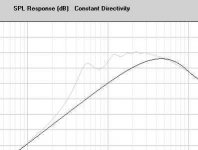Zaph did a test of a wave guide dome tweeter.
As long as the wave guide holds pattern control, the frequencies below where the tweeter starts to beam show a modest rise in output, simply because the waveguide prevents 2Pi radiation. The extent depends on the geometry of the waveguide.
HTH
Doug
As long as the wave guide holds pattern control, the frequencies below where the tweeter starts to beam show a modest rise in output, simply because the waveguide prevents 2Pi radiation. The extent depends on the geometry of the waveguide.
HTH
Doug
The inclusion of a compression chamber is where horns start to show a major increase in power efficiency. With a waveguide on a direct radiator the apparent (and arguably true, so long as you're sitting in the hot spot) efficiency increases because the sound pressure is gathered in a smaller area. I don't think overall acoustic output power increases.
Just a quick question. Is there an increase in a dome tweeter's efficiency when it is loaded in a wave guide? If so how much of an increase is there?
It's not a simple answer because it varies with frequency, horn style ... most of the parameters. Basically a lower frequencies, but above what is usually called the "cutoff" (although the term is misleading) there is an increase in efficiency. But this increase fall off to zero as the frequency goes up ending up at almost no change in efficiency.
But be carefull that you understand and mean "efficiency" because it's not sensitivity or SPL - those act entirely differently because of the changes in directivity.
I understand and I should have asked if waveguides have any affect on sensitivity. I am trying to find a tweeter that is 96db/watt/meters which is hard to do. I was hoping that a waveguide might help me find a tweeter which may be 93db/watt/meters and increase it's sensitivity. I understand the many other benefits of waveguides but I am not so sure it will help me here.
Gedlee I was wondering if you have tried any SET amps with your speakers and how well it worked. I have a Decware Zen amp and I currently have a pair of parker audio 98's I am looking to find a pair of speakers that mates well with my amp but performs more to the level of sound quality I am looking for.
Gedlee I was wondering if you have tried any SET amps with your speakers and how well it worked. I have a Decware Zen amp and I currently have a pair of parker audio 98's I am looking to find a pair of speakers that mates well with my amp but performs more to the level of sound quality I am looking for.
Gedlee I was wondering if you have tried any SET amps with your speakers and how well it worked.
Me? You don't know me very well I guess. I'd use an IPod if thats all I had, and I permanately use a simple Pioneer Receiver. I don't buy the amp thing. But you are quite correct that 96 dB is very hard to do without a waveguide and with a SET you are going to need a very high senitivity. A lot of others use SETs and seem to like them.
But here is the problem. Yes, the waveguide will increase sensitivity of a tweeter, but onlt at the low end. This means that if it 93 dB at the 10 kHz, you can't get above that. You'll get a lot of gain at the low end, and this helps a lot with power handling and excursion, but you can't really extend the sensitivity beyond its high frequency level.
Yeah, it's tough to get 96 dB without some kind of "horn" type device. Orca might sell some ribbons that sensitive, but pricey.
Probably you need to explain more what you are trying to do (i.e. what is the rest of the system? What frequency range are you looking for?) to get more helpful hints.
Probably you need to explain more what you are trying to do (i.e. what is the rest of the system? What frequency range are you looking for?) to get more helpful hints.
Short answer: No. The apparent increase to sensitivity is only over a small range of frequencies, and if you want to use that for anything, it is to try and combat low end roll-off in order to chase a lower crossover frequency.
I.e. you might get +5db axial sensitivity at 1.5khz, +3db at 3khz, and +1db @ 4khz, but anything higher than that will receive no "gain" whatsoever in a given waveguide.
I.e. you might get +5db axial sensitivity at 1.5khz, +3db at 3khz, and +1db @ 4khz, but anything higher than that will receive no "gain" whatsoever in a given waveguide.
You seem like an ideal candidate for a pair of high efficiency speakers. If you're already into DJing, why bother building your own?
For instance, in my situation, I've been studying horns and waveguides for over ten years. Here are a few of the projects I've documented online:
Unity V: The Midbass Strikes Back - DIYMA.com
http://www.diyaudio.com/forums/multi-way/148006-creating-soundstage-waveguides-psychoacoustics.html
Even though I've invested a sizable chunk of time studying these topics, I still can't build anything that could compete with what the pros are doing. If I had to guess, I would say that it would take three solid months of work for me to produce a loudspeaker, and that's at a rate of 40hrs per week minimum. The reason that I publish a new project every six months or so is that I can't devote 40hrs a week to this hobby.
Even if I valued my time at something modest, say $25 per hour, that's about thirteen thousand dollars worth of time. And after three months, I'd likely end up with a speaker that was inferior to what the pros can do.
I know it's a bit silly to tell someone on a DIY forum to go buy a loudspeaker, but you really seem like an excellent candidate.
Putting my money where my mouth is, I listened to the Gedlee Summas in 2005 at the RMAF:
An externally hosted image should be here but it was not working when we last tested it.
Earl from Gedlee on the left, Duke from Audiokinesis on the right. I also met Lynn Olson that day, who has a big thread on this forum.
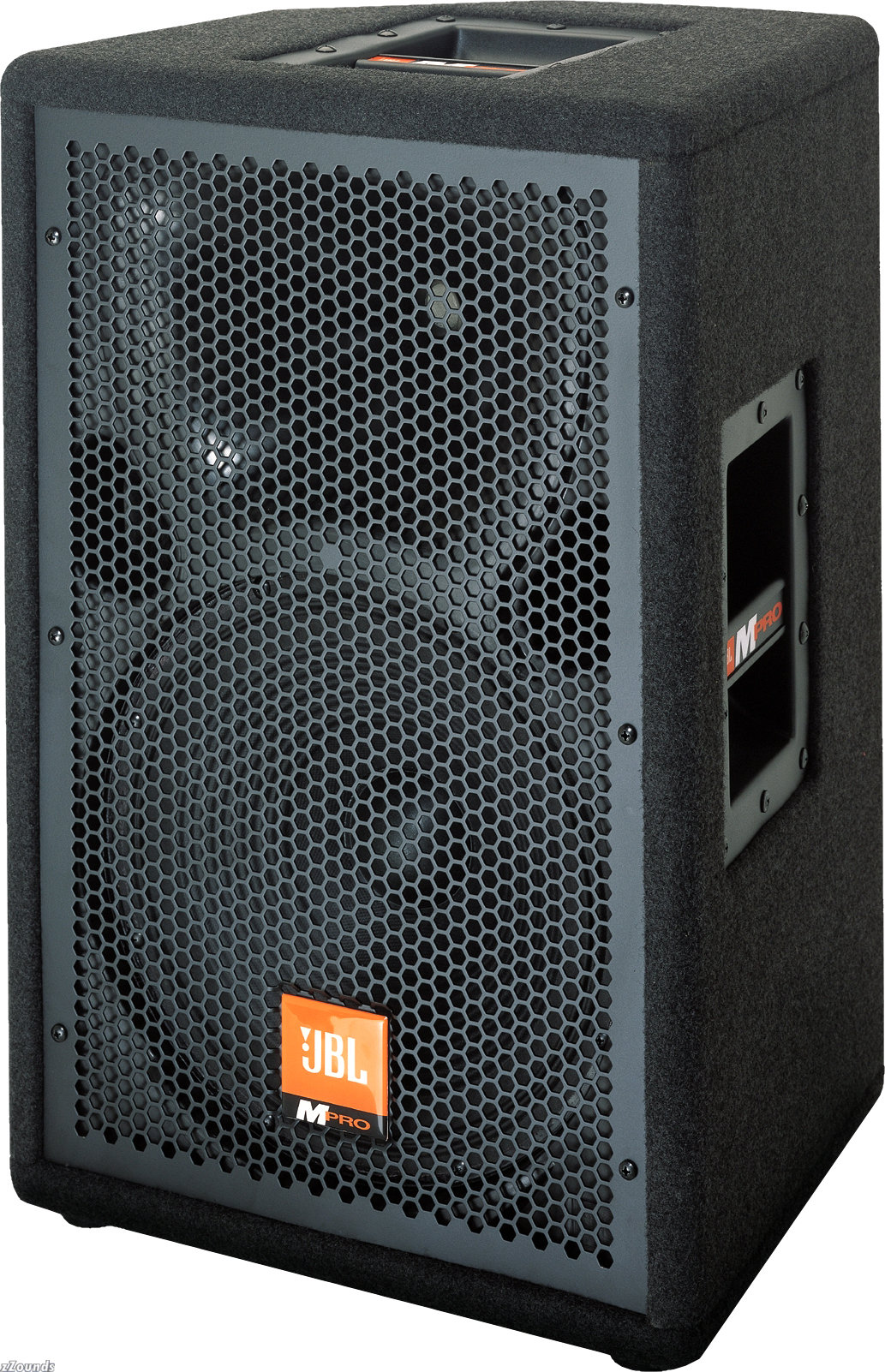
Instead of buying Summas, I bought a set of JBL 2-ways which also use a waveguide and a high efficiency woofer. These JBLs are suspiciously similar to the Gedlee speakers, I wonder if they're following his work?
The JBLs had nice dynamics, but the rolled off treble bugged me, so I went ahead and bought a set of the Summas after living with the JBLs for about a year. And that's the last set of loudspeakers that I've purchased. The JBLs are really no comparison. They *look* similar, but the magic is in the crossover, the waveguide, and the cabinet of the Summa.
This post is admittedly lengthy, but I'd really think twice before experimenting with waveguides when there's a solution that you can purchase which is ideal. The Summas will be a great match for your amplifier. I have personally tried a single ended triode with my Summas, and the results were very pleasant. I ended up going back to solid state for a number of reasons, but there's no reason you couldn't run them with tubes.
The icing on the cake is that my SET is one hundred and twenty MILLIWATTS.
Yep, the Summas are *that* sensitive.
If cost is a concern, keep in mind that rare loudspeakers are a genuine investment. For instance, I've been able to resell my old audio gear on Ebay, often for more than what I paid for it. The trick is to wait until it's no longer in production, and watch as the value begins to increase.
You can see this for yourself on Audiogon. High efficiency loudspeakers that are no longer being made will frequently sell at a big markup over what they cost new.
If only the same thing could be said for my DIY projects! I'd be rich
I disagree with your opinion and you are not really up to date on all the DIY builds over the past year....Waveguides are hot and we are building them. Im hoping Tweak City Audio gets a 2nd generation design done that sells for < $1K because we need that comercial option.
There are many options out there for HIGH QUALITY Pro audio chioces. I know of 4 DJs that build waveguide designs this past year.
Augerpro has a build of a GREAT waveguide over on HTguide.com. He also measured many CDs, waveguides and woofers
http://www.htguide.com/forum/showthread.php4?t=36200&highlight=augerpro
I have a similar build that is active over on AVSForums so do 5 other members there....all DJ and are kicking *** with great designs.
Zilch has 6, Yes now 6 builds on Parts express forum. Range from High SQ qualty to low cost solutions. Its found here...http://techtalk.parts-express.com/showthread.php?t=215536
PaulW on HTguide.com built the Raptor speakers (waveguide designs) and according to everyone at the Atlanta DIY event they are simply incredible.....
build here...http://www.htguide.com/forum/showthread.php4?t=35812&highlight=raptor
The QSC waveguides for < $20 make it very easy to build DIY waveguide speakers. I have compared our waveguide designs vs the QSC HPR-152i and QSC HPR-122i and mine costing 1/3 the price even with my DCX are better. As for two months to build a speaker???? Cmon man, I just took 3 hours to build a complete box (no finish). I can measure that tonight and have a DCX running it tomorrow.
If the guy is need to build a DJ speaker then builds exist and are well documented.
Geddes speakers are not the only game in town. Sure they are the only comercial choices but This is DIY after all
btw, Im not saying Geddes speakers are bad, they should be awesome considering their price tag. Our goal is always to come close to that performance and when we build a speaker for $500 we know what we are getting. I already know there isnt a comercial speaker better then my $700 pair for under $5K and I have spent big $$$ listening and testing over the years.
There are many options out there for HIGH QUALITY Pro audio chioces. I know of 4 DJs that build waveguide designs this past year.
Augerpro has a build of a GREAT waveguide over on HTguide.com. He also measured many CDs, waveguides and woofers
http://www.htguide.com/forum/showthread.php4?t=36200&highlight=augerpro
I have a similar build that is active over on AVSForums so do 5 other members there....all DJ and are kicking *** with great designs.
Zilch has 6, Yes now 6 builds on Parts express forum. Range from High SQ qualty to low cost solutions. Its found here...http://techtalk.parts-express.com/showthread.php?t=215536
PaulW on HTguide.com built the Raptor speakers (waveguide designs) and according to everyone at the Atlanta DIY event they are simply incredible.....
build here...http://www.htguide.com/forum/showthread.php4?t=35812&highlight=raptor
The QSC waveguides for < $20 make it very easy to build DIY waveguide speakers. I have compared our waveguide designs vs the QSC HPR-152i and QSC HPR-122i and mine costing 1/3 the price even with my DCX are better. As for two months to build a speaker???? Cmon man, I just took 3 hours to build a complete box (no finish). I can measure that tonight and have a DCX running it tomorrow.
If the guy is need to build a DJ speaker then builds exist and are well documented.
Geddes speakers are not the only game in town. Sure they are the only comercial choices but This is DIY after all
btw, Im not saying Geddes speakers are bad, they should be awesome considering their price tag. Our goal is always to come close to that performance and when we build a speaker for $500 we know what we are getting. I already know there isnt a comercial speaker better then my $700 pair for under $5K and I have spent big $$$ listening and testing over the years.
Last edited:
The design of a high-efficiency loudspeaker is not trivial. Horns and waveguides are like a microscope, and they have a habit of exaggerating weaknesses in the design.
If you can design a world-class loudspeaker in three hours, you are a better engineer than I am. Realistically, it would take me five hundred hours to build the box, measure the loudspeaker, design the crossover, then refine, refine, and refine some more.
Honestly, I do not think that I could make a design which is competitive with what you can purchase. I could get 80-90% of the way, but that last 10% is elusive.
If you think that creating a world class design is as simple as throwing a couple of drivers in a box and dialing in the crossover, I think you are doing yourself a disservice.
Have you ever noticed that the DIY'ers tend to have a new project every few months? I think that's because they're always seeking something that's a little bit better than the last project.
And it's not like I have a 'casual' interest in audio, or that I'm rich. I am an engineer, and prior to running Summas, I had the kind of loudspeakers you'd buy on an engineer's salary. I owned a set of JBLs with a tractrix horn, then bought a set of Polks because I got sick of the tractrix coloration, then bought a set of JBL prosound speakers because I missed the horn "dynamics." Then I bought some Summas, and *poof*, cured my upgrade-itis.
On the other hand, there are a few guys on this forum that simply purchased 'the real deal.' Sheldon has Unities, William Cowan has Unities, and I have Summas.
And we've been running the same gear for years now. I can't speak for Sheldon or William, but I couldn't be happier with the sound that I have. Then again, William liked his speakers so much he built them into his house!
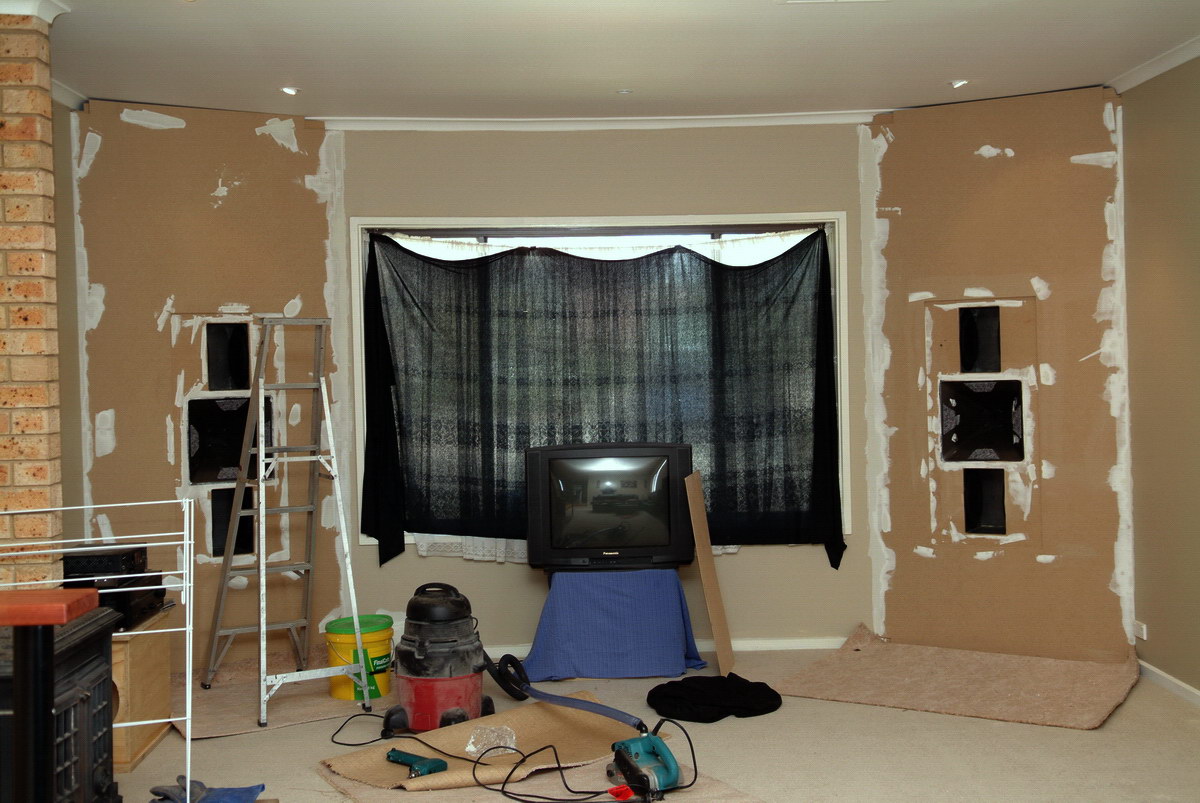
When you built a speaker in three hours, was it so good that you'd do that?
If you can design a world-class loudspeaker in three hours, you are a better engineer than I am. Realistically, it would take me five hundred hours to build the box, measure the loudspeaker, design the crossover, then refine, refine, and refine some more.
Honestly, I do not think that I could make a design which is competitive with what you can purchase. I could get 80-90% of the way, but that last 10% is elusive.
If you think that creating a world class design is as simple as throwing a couple of drivers in a box and dialing in the crossover, I think you are doing yourself a disservice.
Have you ever noticed that the DIY'ers tend to have a new project every few months? I think that's because they're always seeking something that's a little bit better than the last project.
And it's not like I have a 'casual' interest in audio, or that I'm rich. I am an engineer, and prior to running Summas, I had the kind of loudspeakers you'd buy on an engineer's salary. I owned a set of JBLs with a tractrix horn, then bought a set of Polks because I got sick of the tractrix coloration, then bought a set of JBL prosound speakers because I missed the horn "dynamics." Then I bought some Summas, and *poof*, cured my upgrade-itis.
On the other hand, there are a few guys on this forum that simply purchased 'the real deal.' Sheldon has Unities, William Cowan has Unities, and I have Summas.
And we've been running the same gear for years now. I can't speak for Sheldon or William, but I couldn't be happier with the sound that I have. Then again, William liked his speakers so much he built them into his house!

When you built a speaker in three hours, was it so good that you'd do that?
Again, lots of success ful DIY waveguide builds...I posted links. You choose to buy that is cool but this is DIY and we are building speakers. There are other forums to PUSH comercial designs.
I have yet to see a comercial design beat a DIY design in $$$/looks/performance all combine together.
I just believe is a disservice to the forum to tell people to go buy. People are here to have fun building.
btw, I build speakers simply for the pure joy. Im not building to just have a pair of speakers. I have 8 sets now, several unused.
I have yet to see a comercial design beat a DIY design in $$$/looks/performance all combine together.
I just believe is a disservice to the forum to tell people to go buy. People are here to have fun building.
btw, I build speakers simply for the pure joy. Im not building to just have a pair of speakers. I have 8 sets now, several unused.
Shouldn't an engineer have a reference?
Whether you're building loudspeakers, or cars, or web sites, you need a reference point IMHO.
Without a reference, it's just random experimentation. IE, when Nissan wanted to make a world-class sports car, they went and bought a fleet of Porsche 911s, then figured out how to emulate them.
[/font]
Whether you're building loudspeakers, or cars, or web sites, you need a reference point IMHO.
Without a reference, it's just random experimentation. IE, when Nissan wanted to make a world-class sports car, they went and bought a fleet of Porsche 911s, then figured out how to emulate them.
[/font]
I do have a reference, I already posted that I bought the QSC HPR-152i for a weekend and tested them vs my HPR-152i clone build. I have better drivers and I have a better speaker at a much lower cost. I also have heard Danley SH-50s, JBL K2s and so on. I use to own Paradims, Klipsch THX and higher end B&Ws.
heck, Im going to be spending $1500 alone on 3 Raal ribbon tweeters when Im done with waveguides so you are taking to the wrong guy about comparisons, I have about $5K per year alone for just fun speaker projects.
Building speakers is like building models...its all just for fun. Many goals in mind with each build, in the end ZERO friends/family have heard the quality in the speakers they own vs my speakers....does it match Geddes? Probably not, do any of us care, Not at all. You can not spend $1K on comercial speakers to get DIY quality. Heck for $500 you have a serious HT main speaker that is unmatched by anything comercial < $1K. That matters more then worrying about having a porsche.
This isnt about you or me though. Not everyone out there cares to have a porsche either, there are a thousand goals inbetween and people just need to define their own goals. You may think only Geddes speakers will do but the majority DIYers will disagree with you on that (since few even own them). Again, look at the 100+ econo waveguide success stories. Look at the 20+ builds happening on AVS, Tech Express and HTGuide.com. Did you even look at Paul W. Raptors or his incredible waveguide designs BUILT into his HT room (The octagon)???....DIY for some is just better!!
The OP had a question about sensitivity...He didnt ask for your opinion on if he should buy instead of building period so I find this whole discussion completely off topic to the thread.
If you choose not to build then fine, go push comercial speakers in comercial forums.
heck, Im going to be spending $1500 alone on 3 Raal ribbon tweeters when Im done with waveguides so you are taking to the wrong guy about comparisons, I have about $5K per year alone for just fun speaker projects.
Building speakers is like building models...its all just for fun. Many goals in mind with each build, in the end ZERO friends/family have heard the quality in the speakers they own vs my speakers....does it match Geddes? Probably not, do any of us care, Not at all. You can not spend $1K on comercial speakers to get DIY quality. Heck for $500 you have a serious HT main speaker that is unmatched by anything comercial < $1K. That matters more then worrying about having a porsche.
This isnt about you or me though. Not everyone out there cares to have a porsche either, there are a thousand goals inbetween and people just need to define their own goals. You may think only Geddes speakers will do but the majority DIYers will disagree with you on that (since few even own them). Again, look at the 100+ econo waveguide success stories. Look at the 20+ builds happening on AVS, Tech Express and HTGuide.com. Did you even look at Paul W. Raptors or his incredible waveguide designs BUILT into his HT room (The octagon)???....DIY for some is just better!!
The OP had a question about sensitivity...He didnt ask for your opinion on if he should buy instead of building period so I find this whole discussion completely off topic to the thread.
If you choose not to build then fine, go push comercial speakers in comercial forums.
Last edited:
Patrick Bateman I have followed your posts on DIYMA for a while and I actually work in the mobile audio industry. I also used to work as an installer at Tweeter audio in the early 2000's. I think waveguides would could work great in a car audio environment if you could just find a way to implement them. I think for that to happen you would have to search out the right car with the right dash to get that to work. Feel free to PM me or email me if you would like to chat about car audio more on this.
I stopped DJing years ago but i still dabble here and there when the right opportunity arises. I have a pair of EV eliminator cabs that are considered some of the best as far as pro audio goes. They only sound ok with my SET even though they get loud enough.
The reason I started this whole thread was to see if I could find some way to improve the speakers I built to go with my SET. I built them years ago and had to put all my audio equipment in storage while I was away at school. Now that i have moved back from school and I am working in the audio industry I am interested in getting involved in my old hobbies again.
The Parker audio 98's with the fostex tweeter still sound good but now I want more. Specificly I want a better tweeter and more bass. I was going to start with trying to replace the tweeter with something better and was hoping a waveguide might help me reach the 96db I need to match the midbasses. I understand the benefits of a waveguide but I was unsure if it helped raise sensitivity like a front loaded horn would. Now that I know it doesn't, it's back to the drawing board. I feel that I may be building new speakers at some point with completely different drivers to try to get to where I want to be.
BTW I use mackie hr624 as my reference speakers for most everything because they do so many things right.
I stopped DJing years ago but i still dabble here and there when the right opportunity arises. I have a pair of EV eliminator cabs that are considered some of the best as far as pro audio goes. They only sound ok with my SET even though they get loud enough.
The reason I started this whole thread was to see if I could find some way to improve the speakers I built to go with my SET. I built them years ago and had to put all my audio equipment in storage while I was away at school. Now that i have moved back from school and I am working in the audio industry I am interested in getting involved in my old hobbies again.
The Parker audio 98's with the fostex tweeter still sound good but now I want more. Specificly I want a better tweeter and more bass. I was going to start with trying to replace the tweeter with something better and was hoping a waveguide might help me reach the 96db I need to match the midbasses. I understand the benefits of a waveguide but I was unsure if it helped raise sensitivity like a front loaded horn would. Now that I know it doesn't, it's back to the drawing board. I feel that I may be building new speakers at some point with completely different drivers to try to get to where I want to be.
BTW I use mackie hr624 as my reference speakers for most everything because they do so many things right.
Patrick Bateman I have followed your posts on DIYMA for a while and I actually work in the mobile audio industry.

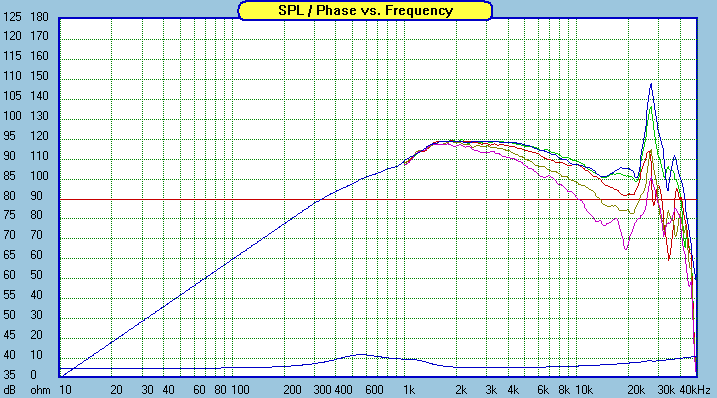
Basically, the efficiency of a conventional dome won't cut it with an SET.
I've listened to my Summas with an SET, and *yes*, it *did* sound different. Nice image, bloated bass, limited dynamics. But I was using a headphone amp. With three watts you'd be off to the races.
Single ended triodes have a way of "taking the edge off" of a brittle tweeter. Of course part of this is because SETs are not well behaved at the frequency extremes.
There's no substitute for a great tweeter and a great waveguide. As I mentioned in the last post, I personally believe that the simplest solution is to just buy a finished speaker, or a kit, from Geddes. The engineering is first-rate, and so are the parts.
There are competing solutions, which are more affordable.
I've done A/B comparisons of my JBLs against the Summas. I haven't heard Zilch's speakers. To my ears, the cabinet and the foam plug plays a big part in making the Summas "disappear." Basically, the JBLs can get loud, have great dynamics, and they're pretty damn listenable. But the high end response of the Summas is better, and the imaging is in a whole 'nother ballpark.
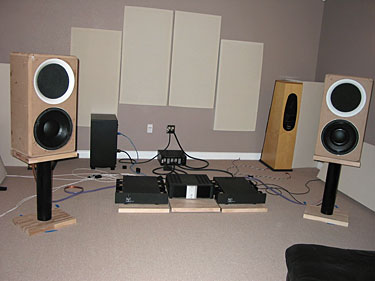
Gedlee Abbeys
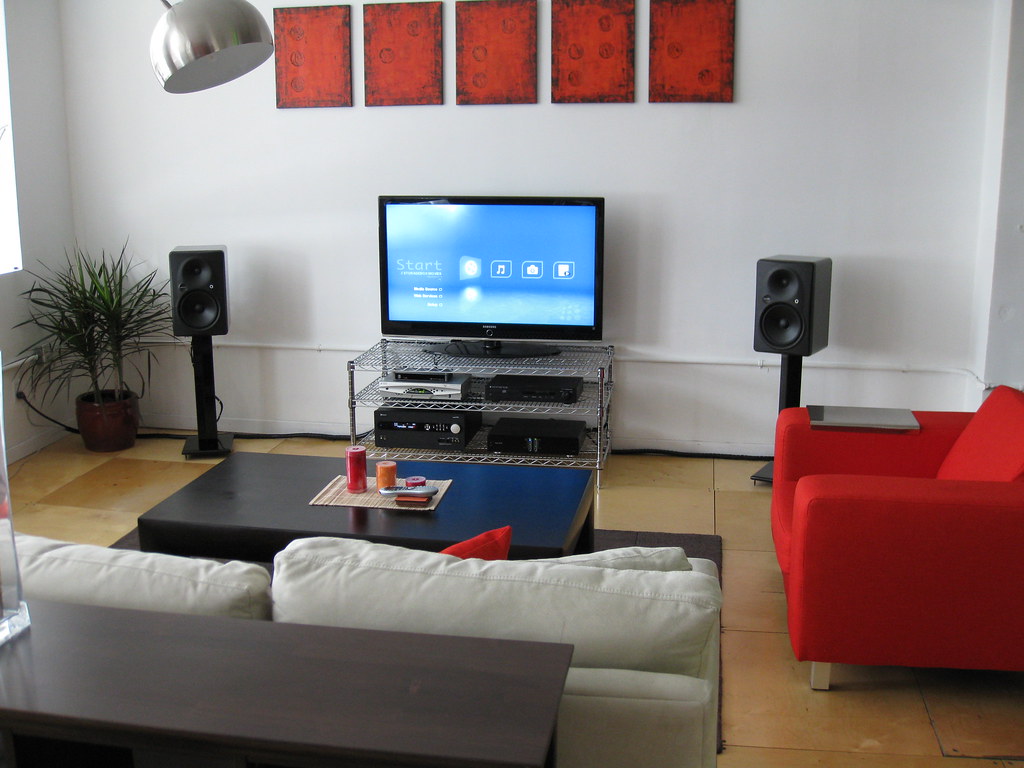
Mackie HR6242
Zilch Econowaves
I think a lot of this is going to boil down to one thing: how important is imaging to you?
In your message, you stated that you are happy with the sound of the Mackie HR624. It is my belief that there's more to imaging of the Gedlee speakers than just the choice of drivers. In my opinion, it's the engineering. Take a look at the three pics above, and tell me which speakers are the closest match for the Mackies that you already like.
I've listened to my Summas with an SET, and *yes*, it *did* sound different.
Yes, I had this experience as well and took some time to sort out what this was caused by. It's the generally much higher output impedance of the tube amps that causes a significant change in the frequency response of the crossover. I design to +- 1 > 2 dB and the high output impedance changes the response by more than this amount. So, of course, its going to be audible. And maybe it is "more pleasant", but it is certainly not more accurate. This effect can be easily accomodated in the crossover if the output impedance is known. Problem is that the value is different for every design. Makes it impossible to do an optimal correction for anything but a specific value and "0" seems like the best choice to me.
- Status
- This old topic is closed. If you want to reopen this topic, contact a moderator using the "Report Post" button.
- Home
- Loudspeakers
- Multi-Way
- Waveguide effect on speaker efficiency
